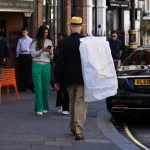The Bank Julius Baer Tells You Where To Live, If You’re Rich
The idea of luxury once stood for fancy goods, now it has morphed into a broad category
“In which city is it going to be cheaper to buy a piano?” This is exactly the question Swiss bank Julius Baer has answered for its clients in a new ranking of luxury goods and services in 28 cities around the world. For private banking clients, this type of thing matters and Julius Baer looked at items and services their clients buy regularly. “The inaugural edition of Julius Baer’s Global Wealth and Lifestyle Report 2020 showcases the trends in high-end consumption around the world, which are of relevance to our clients,” says Rajesh Manwani, head of markets and wealth management solutions Asia Pacific at Bank Julius Baer.
Hong Kong (1) is the most expensive city in the world according to Julius Baer’s ranking of luxury goods and services, in spite of protests that dominated the city in 2019. “One of the factors here is currency, so the way you take local prices and you convert into dollars to give that purchasing parity”, explains Julius Baer’s Ed Raymond, head of Portfolio Management UK. Property prices have fallen in Hong Kong in 2019, but other luxuries are just as expensive as when Hong Kong topped Mercer’s Cost of Living Survey in June last year. Shanghai and Tokyo join Hong Kong in the top three most expensive cities in the world, while not far behind are Singapore (5), Taipei (8) and Bangkok (11). But if wealthy individuals want cheap goods in the region, they should head to Mumbai, India, which is the cheapest of all the 28 cities studied. In Mumbai, the rich can find personal trainers at 10% of the all city average, and property at 12%. Be warned, though, pianos are expensive here.
Despite being the home of haute cuisine, Paris is the most expensive city in the world for fine dining. This makes it the 12th costliest city in the world and the fourth most expensive in Europe after London (7), Zurich (9) and Monaco (10). While Europe “offers the best overall value for high-end items”, in the words of Julius Baer, expensive property mean it’s cities are costly even for the wealthiest. Monaco has the highest real estate prices in the world: $1 million buys just 16 square meters according to Knight Frank’s Wealth Report.
Only three U.S. cities made the cut: New York (4), Los Angeles (6) and Miami (13). South America, by contrast has a far smaller market for luxury goods. Prices are therefore inexpensive for wealthy in cities like Mexico City (18) and Rio de Janeiro (16), where hotel suites and wedding banquets come cheap. In Vancouver, however, more than half of the 20 luxury items in Julius Baer’s index are below the global average price. The Canadian city ranks 21st on the global list and the cheapest in the Americas.
High local tax rates make Rio de Janeiro – Brazil’s second-largest city – the world’s most expensive metropolis in five of 18 categories in the Swiss bank’s inaugural Global Wealth and Lifestyle Report.The report underscores the growing scope of opulence among the world’s wealthy as tensions mount in some nations over the divide between the rich and everyone else.
The idea of luxury “once stood for fancy goods, such as handbags or sports cars”, Mr Nicolas de Skowronski, head of wealth management solutions at Julius Baer, said in the report. “Now it has morphed into a broad category that includes services and experiences, from fine dining to new lifestyle trends such as wellness.”
Younger consumers, for instance, value experiences as much as things. They seek whatever that can enhance their own health, skills and happiness. A study of six thousand millennials across ten countries by ZenithOptimedia found that they wanted to become a ‘problem-solver’ or ‘decision-maker’. They had less time for conventional priorities such as getting married, having children or buying a house. This fits: we know that the wealthier countries are and the higher women’s participation in the workforce is, the later people tend to settle down. There are also cultural biases. A fifth of Chinese millennials, versus an average of 9%6, consider being ‘well travelled’ as a major feature of adulthood. The conclusion seems to be, then, that younger consumers are less materialistic than past generations.
Date: 21st January 2020
Source: newsgateny.gfarm.it
Author: Ally McLean






